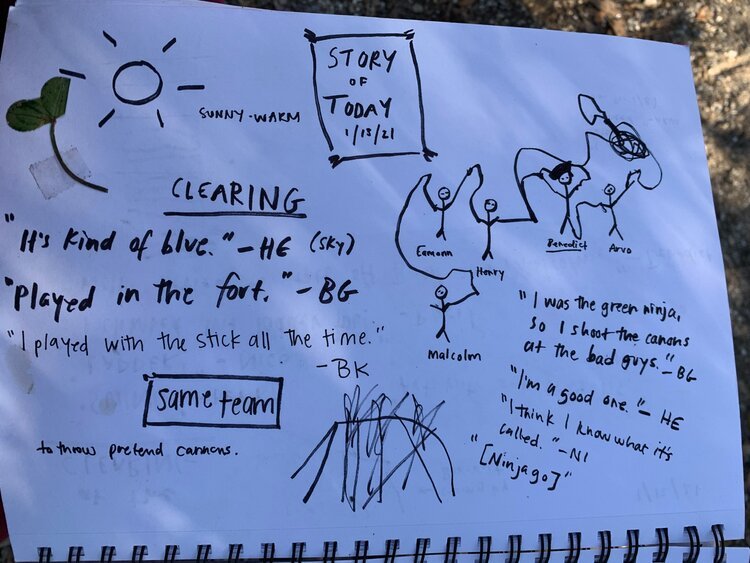Reflecting on Experiences with Children
One of our floobook pages - A Story of the Day
Over the past few weeks in the forest, one of the things I’ve enjoyed most is reflecting with my children on their lives. Although it’s not revolutionary by any extent of the imagination, it’s an important piece component of practice, whatever your station.
In our program, we incorporate elements of the floorbook approach (1, 2) where children gather together around a central book that is there solely to capture their ideas and experiences. Floorbooks include children’s words (written and dictated), children’s pictures and other marks they make, and pictures of the children at work. The idea of the floorbook as we see it is to illustrate and make tangible the curriculum that is constantly unfolding within our classroom life.
Recently, one additional piece of our floorbook has been incorporating pictures of the children from the previous day or days of play. I’ve found that for our group of children, lunchtime is the best time to engage in the reflection process. It is a natural pause in the day where conversation becomes slower and the children’s minds shift from the intensely interactive and social morning to the more reflective afternoon.
A few bites into lunchtime, I pull out our floorbook, a pen, and at least one photo. Then, I begin with a couple of questions:
“Do you remember this?”
and
“What is happening here?”
I do my best to be nonjudgmental in my opening questions. After all, I don’t want them to say what they think I want to hear. Instead, I am curious about what they want to share. These questions are generally good in that they get the children speaking but don’t require any particular direction or topic to be broached. As the children speak, I write, and ask clarifying questions related to what they say.
Sometimes, however, I do have more particular questions. For example, one chilly Monday I pulled out a picture of the children running around, wielding sticks in their hands. It was the sort of big body, gross motor, weapon play they had taken to over the previous weeks.
“Why do you all like this play so much?” I asked between chews.
“I like to throw sticks so far,” one child answered.
“I like taking sticks out of other people’s hands,” came another answer, after some consideration.
“This game is called Stick Fight,” another added.
“We were trying to catch [our friend].”
There is something about these answers that makes me so grateful to work with the children. The truth is that these answers are self-evident. Any adult who looks at these pictures of even has a sliver of memory of what it meant to be a child could likely guess and at least understand the nature of these answers. However, engaging in this photo-stimulated discussion has many benefits:
Children are reflecting on their own experiences.
Children share their own unique perspectives with peers who listen.
Children learn that same photos/events elicit different reactions and interpretations. (And that all of these have a place in our collective memory).
Children see that their process and play are valuable enough to warrant physical space in our classroom chronicle and worth an extensive discussion on a communal scale.
How will you reflect with your children? Or do you already?
An interesting modification to this practice would be to use a special app on your phone or iPad to capture special moments. (I recommend a separate app or device because camera rolls (at least my camera roll!) can be chock full of photos that may also seem less special than those ported into a special location.
Further, if photos are not your forte, children’s created artifacts (such as those assembled in a more traditional portfolio) are also a wonderful place to begin. You might write children’s words, or invite them to share aloud into a voice recorder to play back later, or otherwise memorialize what they say.
Happy reflecting, friends! Feel free to reach our via email or on instagram and share your reflective process experience! Or comment below!



